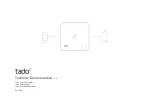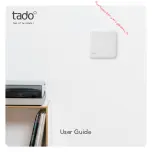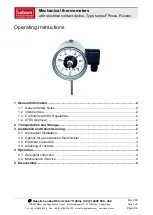
TEC20x6(H)-2 Series Wireless Thermostat Controllers with Two Outputs,
Dehumidification Capability, and Three Speeds of Fan Control
1
Applications
The TEC Series Wireless Thermostat Controller
System provides wireless networked control of
Heating, Ventilating, and Air Conditioning (HVAC)
equipment on a Building Automation System (BAS)
that enables remote monitoring and programming. This
TEC Series System integrates into a supervisory
controller using BACnet® Internet Protocol (IP) or
BACnet Master-Slave/Token-Passing (MS/TP)
communications.
TEC20 Coordinators allow the supervisory controller to
communicate with multiple TEC Wireless Thermostat
Controllers. TEC20x6(H)-2 Series Wireless Thermostat
Controllers control two- or four-pipe fan coils, cabinet
unit heaters, or other equipment using on/off, floating,
or proportional 0 to 10 VDC control input, three speeds
of fan control, and dehumidification capability.
The wireless mesh network uses ZigBee™ technology
to enable remote monitoring and programming and to
enhance reliability by providing redundant transmission
paths through other TEC Wireless Thermostat
Controllers, creating a resilient, self-healing mesh
network.
North American Emissions Compliance
United States
Canada
IMPORTANT:
The TEC20x6(H)-2
Series Wireless
Thermostat Controllers are intended to provide an
input to equipment under normal operating
conditions. Where failure or malfunction of the
thermostat controller
could lead to personal injury or
property damage to the controlled equipment or
other property, additional precautions must be
designed into the control system. Incorporate and
maintain other devices such as supervisory or alarm
systems or safety or limit controls intended to warn
of, or protect against, failure or malfunction of the
thermostat controller.
This equipment has been tested and found to comply with
the limits for a Class A digital device pursuant to Part 15 of
the FCC Rules. These limits are designed to provide
reasonable protection against harmful interference when
this equipment is operated in a commercial environment.
This equipment generates, uses, and can radiate radio
frequency energy and, if not installed and used in
accordance with the instruction manual, may cause
harmful interference to radio communications. Operation
of this equipment in a residential area is likely to cause
harmful interference, in which case the user will be
required to correct the interference at his/her own
expense.
RF Transmitters: Compliance Statement (Part 15.19)
This device complies with Part 15 of the FCC Rules.
Operation is subject to the following two conditions:
1.
This device may not cause harmful interference, and
2.
This device must accept any interference received,
including interference that may cause undesired
operation.
Warning (Part 15.21)
Changes or modifications not expressly approved by the
party responsible for compliance could void the user’s
authority to operate the equipment.
This Class (A) digital apparatus meets all the requirements
of the Canadian Interference-Causing Equipment
Regulations.
Cet appareil numérique de la Classe (A) respecte toutes
les exigences du Règlement sur le matériel brouilleur du
Canada.
RF Transmitters: Industry Canada Statement
The term
IC
before the certification/registration number
only signifies that the Industry Canada technical
specifications were met.
Le terme « IC » précédant le numéro d'accréditation/
inscription signifie simplement que le produit est conforme
aux spécifications techniques d'Industry Canada.
TEC20x6(H)-2 Series Wireless Thermostat Controllers with
Two Outputs, Dehumidification Capability, and Three
Speeds of Fan Control
Installation Instructions
Part No. 24-9890-765, Rev. A
Issued August 31, 2009
Supersedes March 17, 2008


































